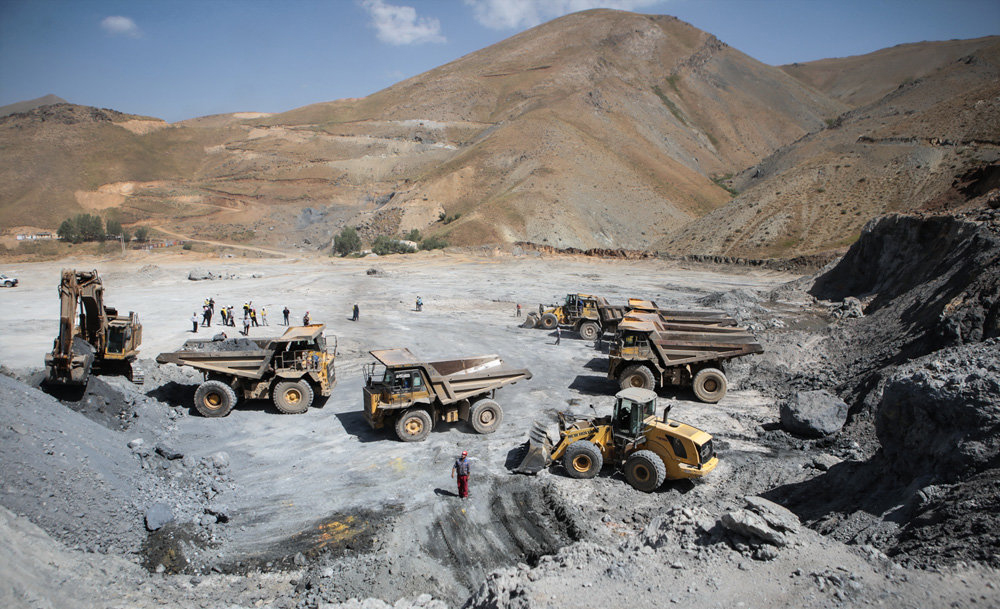Zarhsouran Gold Mine produced 137 kilograms of gold ingots during the first four months of the current Iranian year (started March 20), which indicates a fourfold increase compared to the similar period of the previous year, CEO of Zarshouran Gold Mine and Mining Industries Development Company said.
“We are planning to produce 600 kilograms of gold in the current Iranian year (March 2016-17),” Mohammad Reza Ahmadi was quoted as saying by Iran Mines and Mining Industries Development and Renovation Organization’s news portal.
Zarshouran, located 35 kilometers from Takab in the northwestern province of West Azarbaijan is Iran and Middle East’s richest gold deposit. It holds 108 tons of proven reserves, in addition to 50 tons of silver, according to the official.
Further explorations in the area are expected to increase the gold reserve to 150 tons.
The mine draws on a special method developed by an Iranian company that uses chemical reactions for extracting gold.
So far, more than $44 million have been invested on the development of the mine which, in addition to gold, has the capacity to produce 2.5 tons of silver and 1 ton of mercury per year.
The mine began production in 2014 at one plant. It produced 175 kilograms of gold bars and 110 kilograms of silver bars last year (March 2015-16).
Last year, the Zarshouran company sold 134 kilograms of gold ingots at Iran Mercantile Exchange.
The government is considering a second development phase, as soon as financial resources become available.
IMIDRO recently announced plans to sell 700 billion rials ($20 million) worth of Musharakah bonds—an Islamic mode of finance in which capital is provided by two or more parties for project development—to raise money for development of Zarshouran’s second phase.
Ahmadi said the construction project will soon be tendered.
Iran is the fourth largest producer of gold in the Middle East and 54th in the world, according to Ahmadi.
Zarshouran’s ultimate objective is to produce 3 tons of gold annually which, if materialized, will put Iran in the third regional position, above Saudi Arabia.
> Other Iranian Gold Mines
Sari Gunay Gold Mine in the western province of Kurdestan is Iran’s second-largest gold deposit with 63 tons of estimated reserves and an annual output of 2 tons. It was Iran’s only gold mine that has attracted foreign direct investments throughout its development.
Back in 2009, the world-renowned Rio Tinto Group took an interest in Sari Gunay and formed the joint company Zar-Kouh with two Iranian mineral firms to conduct exploration operations at the mine. The cooperation, however, did not last long.
By the time the mine’s reserves were determined, the British–Australian company gave up on exploiting Sari Gunay, describing it as “uneconomical” due to the mine’s low gold grade.
Following a short-lived presence of a Chinese company at the mine, the government allowed Kazakhstan-based EMC Company to operate Sari Gunay with a direct investment of nearly $63 million in cooperation with Zar-Kouh Company.
The gold mine, located 90 kilometers east of Sanandaj, was supposed to start operation in September 2013. The deadline was extended until October 2014 but EMC once again missed the deadline.
The mine finally became operational in late January and is currently operated by Zar-Kouh.
Iran's other gold-rich mines include Aq Darreh and Kharavan in northwestern Iran, each with a capacity of 30 tons.
Kouh-Zar in the northeastern Khorasan Razavi Province with 15 tons and Mouteh in the central Isfahan Province with 14 tons of gold reserves are ranked Iran’s fourth and fifth biggest gold mines respectively.
In terms of grade, Kharavan (4 grams per ton), Kouh-Zar (3.3), Aq Darreh (2.7) and Mouteh (2.5) follow Zarshouran respectively.
Three gold mines have been recently discovered in Zanjan Province and are awaiting feasibility studies for exploitation.


